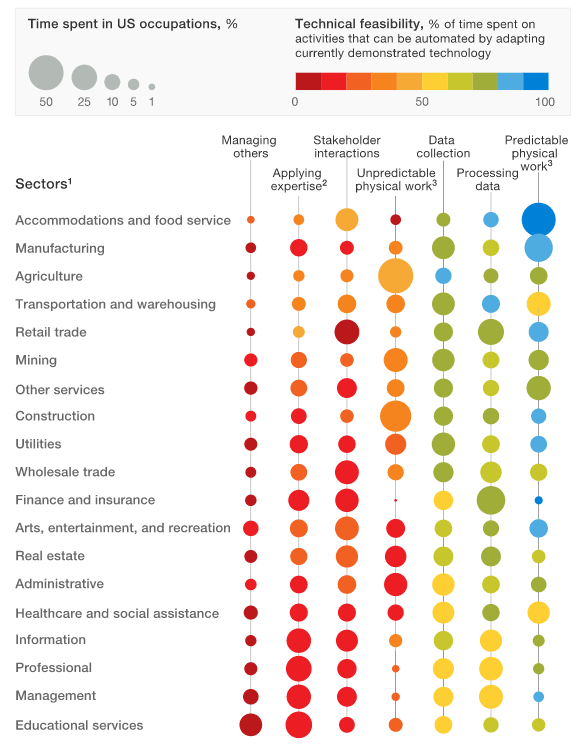
By recent estimates, something like 47% of jobs face the threat of being automated over the next 20 years. That means that what was once done by humans alone will now be done by a machines and algorithms.
As more of that 47% becomes a reality, all eyes are fixated on that other 53% — the stuff that we used to think was solely the realm of human capacities. If you go back as far as Aristotle and the early scientists, it was reason that made humans unique in the world. And until humans built machines that could use the same logic they do, that was true.

Now it isn’t reason that sets humans apart. We learn to reason the same way that machines do; after all, we taught them how to do it. We are becoming sympatico in that respect. Only now, machines can already do it faster and more efficiently. They can take the inputs that we take, and make judgments more quickly — allowing for faster implementation of decisions, often without humans even being involved.
So what’s left for us humans? And how do we ensure that the remaining 53% of jobs keep their essential human elements?
Rationality is No Longer an Advantage, but Creativity Is
It used to be that reason was the uniquely human trait. It was what separated us from the other complex organisms. Since the advent of sophisticated computers, that trait seems to have been perfected by the machines. With computers being able to “think through” problems and solve them, reasoning has become the arena in which humans consistently come in second place.
That means that it is not rationality — logical thinking — but creative thinking where humans have the edge. We humble humans may be slowed down by tricky syllogisms, but only we can make up ideas from whole cloth. Only we can throw off the shackles of established thought.
Creativity is really an inclination more than anything. It’s a mode of thinking — one that refuses to take on assumptions without question, that looks for the new and untested rather than the traditional and accepted. Creativity involves embracing risk, venturing out into the deep end, past the ropes that others have set up to mark off the safe areas in which to swim.
But just to be clear here, the most creative people can often venture out past the boundaries without even realizing — or even caring. This is because some of the best creative work comes as the result of one thing: play.
The Power of Play
You are not a computer. You can color without a set of lines and instructions. The sky can be polka-dotted, the clouds can be striped. You can abandon rules and conventions — at least for a time. You can disrupt and ideate in a way that a programmed machine cannot.
So if you’re still reading this, remember and hold dear this edict:
I can create something new. I can wander for the sake of wandering. I have that uniquely human power.
We are All Creatives
I think that we assume a separation between those doing “creative work” and, well, everyone else. However, I have my doubts that there really is such a separation. Furthermore, I think that believing in such a separation may actually be harmful — to everyone.
We are all “creatives”.
There is a place in all of our work for creativity. Every kind of work can benefit from it. In fact, it is those jobs where we often don’t see a need for creativity that most badly need a creative touch. That elusive and desirable thing that so many in the business world chase — innovation — is often a direct result of creative thinking in the very places that no one expects it. This is because creativity is what makes us human.
So take the mundane job that automation might threaten, and ask what illogical and emotive tasks can be built-in. Ask what personal and emotional connections there are that can provide better interactions between people, better collaboration, and spontaneous advancement. They are there — you just have to think creatively.
Venture Outside the Lines
At least for the foreseeable future, computational thinking needs to color within the lines. There may be an increasing number of lines that it can color within, but the lines are necessary nonetheless.
We as humans have the ability to see the lines, understand them, and then venture far outside of them — to bring back ideas and connections that weren’t within the bounds of logical thought structures.
So use that power. Observe and note the lines — understand them — then color outside of them. Do so without regard for what the goal is — the goal is simply to wander. Everything else is secondary. I think you will find that enough of that wandering will yield some truly wonderful things. Those things can then be injected back into the humdrum activities of daily life for whatever goals you have adopted. Or perhaps, they will reveal entirely new goals toward which to strive.
Go forth and play. Know the rules and abandon them for a spell. Swim in that uncharted water, then return and tell us what you found.
